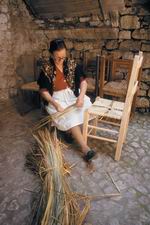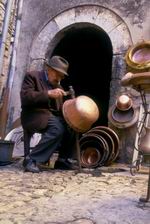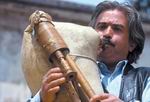| |||||
 |
Folklore and crafts in Ciociaria | ||||
| Handicraft, fair and events along the lanes of ancient villages. | |||||
| Related images (1) |
|
The handicraft in Ciociaria has always been a vital activity from ancient Roman times to the last postwar period. Along the lanes of the old towns f our villages, the workshops of the craftsmen have always been booming, becoming an important sector of the whole economic network of this land. Although the advent of the industrial production gave a hard blow to handicraft, today many sectors are still active and have gained an artistic value, greatly appreciated by the more attentive consumers. Well developed, especially within the territory of Sora, is the furniture industry, appreciated at national level, which still has a man-made element, expressed through the valuable intarsia handcarved by skilled wood-carvers working in this area for centuries. In the Centro Fieristico of Sora, every year a trade of industrial and man-made furniture takes place and gathers an increasingly greater number of visitors. Wood is the main material used to create a lot of tools, mainly farming tools which the rural tradition of our land, and other objects still in use in our modern homes, namely kitchen spoon, spoons, food containers, such as the typical 'scifette', small wooden trays traditionally used to serve such dishes as 'fettuccine', 'gnocchi' and 'polenta'. In many towns of the province hand-woven wicker baskets in all sizes and shapes, wicker shopping bags are hand made, as well as the traditional chairs in unpolished wood and woven-straw. Another relevant sector is that of wrought-iron, especially concentrated in Veroli, where every two years a Wrought-Iron Exhibition is held, which gathers craftsmen from all over the land and from abroad, too. During the exhibition these iron forgers shape metal directly under the eye of the visitor. The most appreciated works are beds, lamps, railings and handrails. Another metal worked for the production of traditional objects is copper forged in many shapes and for many purposes. The copper tool par excellence, the one that embodies the symbol of Ciociaria's land is the 'concone', a container once used by women to draw water from wells and springs which has been confined today to a mere ornamental function. Another sector, cutting across industry and handicraft, is the manufacturing of marble dug in the local quarries, especially those of Coreno Ausonio whose marble, known as the 'pearly Royal', is well appreciated on the international market. Thanks to the skill of the Ciociarian marble-workers, real stone sculptors that work in the Comino Valley and around Anagni, as far as travertine manufacture is concerned, valuable manufacts are produced and embellish the interior and exterior parts of buildings and constructions. Among the expressions of artistic handicraft, there are also the precious embroideries made by the skilled hands of Ciociarian women. Unfortunately this kind of activity, handed down from mother to daughter, is almost disappearing, and the number of those taking up this art reduces by the day. Yet this contributed to raise the value of the masterpieces made, so blankets, table clothes, towels and the likes that fit a bride's trousseau are still today embellished on request with graceful embroideries by the nuns living in their institutes of Boville Ernica, Veroli, Arpino, Isola del Liri. Many of the most refined sacred vestments are still hand-embroidered in Anagni, the “popes' town”. Finally there is the manufactuirng of leather, once used to make the 'ciocie', another symbol, togheter with the 'concone', of the Ciciarian traditions. These are rustic footwear worn in the past by Ciociarian pheasants and made of a leather sole tied from the ankle to the calf by means of thin laces. Once the poor's shoes, these are today the most popular souvenir of Ciociaria.
Fairs and Folklore Ciociaria has a full calendar of food fairs, entertainment events and musical festivals, as wells as a variety of tradinational feasts. Religious, country and rural traditions are still strong and alive. The celebrations of the patron saints with the processions, the performance of bands, singers and groups, the illuminations and fireworks, the fairs and popular games, the palios and tournements among the town's quarters witness the desire of the Ciociarian people to preserve intact the authenticity of their pesant culture expressed with the typical costumes, music, rites and gastronomy.
Ciociarian folk groups have also taken part to important events held outside the territory. These relationships held by folk groups with other countries give the opportunity to increase friendship and understanding among the peoples of the world, as well as being an opportunity for the Ciociarian emigrates scattered all over the world to strengthen the ties with their homeland. During popular events people wear ancient costumes with the typical footwear, the 'ciocie', which gave the name to this region. Part of the Ciociarian folklore are the songs, both sacred and profane, dances such as the 'saltarello', accompanied by the music of the accordion and cheered by the genuine dishes of our cuisine.
FAIRS A great number of food fairs are held in the towns of this province to promote the typical dishes and the produces of the land: the fair of fried pancakes at Paliano and Vicalvi, the cherries fair at Pastena, the fair of soaked bread at Sant'Elia Fiumerapido, the snails fair at Castro dei Volsci, the fair of the 'crespelle' (fried leavened cakes) at Veroli, with a typical chart parade with personages in costume that embody episodes of rural life in the last hundred years; the chicken and peppers fair at Isola del Liri, at Pontecorvo and Pignataro, the fair of “abbottapezzienti” at Aquino, the polenta fair (corn flour soup) at Villa Latina, the fair of the 'lachena' at Castro dei Volsci and Collepardo devoted to homemade 'fettuccine' seasoned with a special sauce, the 'gnocchi' fair at Acquafondata, the fair of the 'acquata, and roasted chestnut at Patrica, the truffle fair at Campoli Appennino, and finally the host of fairs devoted to grapes and typical wines. In the old cellars of Piglio's old town, the event 'Open Cellars' takes place, during which it is possible to taste the Cesanese and Passerina wines with some typical food, as well as buying handicraft objects. The historical parades and music festivals are also very important. Of interest re the Zampogna Festival at Acquafondata; the Gonfalone at Arpino, where the town's quarters challenge each other in tournements in Ciociarian dress; the Palio of the 'Concone' at Castro dei Volsci; the Threshing Feast at Colle S. Magno, a fair that enacts the stages of wheat threshing with ancient tools; the Feast of the Emigrant at Vallerotonda; The Folf Festival 'The Sound Roots' at San Giorgio a Liri; the International Folklore Festival at Atina and Alatri; the 'Saltarello Feast' at Collepardo, etc. Extremely interesting are the historic pageants, which faithfully recreate the Middle Ages atmosphere with very refined settings and costumes. The best-known historic parades are held at Anagni, Cassino, Ferentino and Paliano. Other traditional happenings of the Ciociarian culture are the religious ones. In addition to the number of processions, remarkable is the staging of the Nativity and Christ's Passion, held now every year in many towns, namely Alatri, Pofi and Cervaro. Extremely captivating, also from an artistic point of view, are the flower festivals held on Corpus Christi Day, when all people are busy arranging long carpets made of flower petals featuring religious images that wind along the streets of the old town, and creating in this way real masterpieces.
EVENTS Among the most important cultural events that are organized every year in Ciociaria, there are the 'Liri Blues' and 'Atina Jazz', the 'Certamen Ciceronianum' at Arpino, the 'medieval and Renaissance Theatre Festival' at Anagni, the 'Fasti Verulani' and the 'Street Theatre Festival' at Veroli. The Liri Blues is a prestigious happening that has by now become an yearly influential appointment. Eminent personalities of the music stage are increasingly more numerous. In the past years, Piazza Boncompagni, which during the event accommodates a flood of people, witnessed the participation of prominent bands. A novelty of the last years is an itinerant Liri Blues, which brought some shiws in other places within the province. Atina Jazz is a music event which sees the partecipation of personalities from the international stage. All the greatest jazz players performed in Atina, drawing in this way the attention of a large audience. The Fasti Verulani managed to recreate a magic relationship between the artist and the audience. The event, hald in the first week of August, has become the mark of a review, unique among the Italian festivals of street theatre. Other major music events taking place here are: the 'Ernico-Simbruina' International Festival featuring a series of concerts in different places; classic concerts are hald by internationally renowned artists and orchestras for the review 'Soraclassica'; the International Festival of 'Severino Gazzelloni' at Roccasecca is also a review of classic music concerts during which scholarships are granted to young promising flute-players.
Texts and photos courtesy of A.P.T. di Frosinone
| |
 |
Search other Guides |
Related arguments
| Abbeys, churches and sanctuaries in Ciociaria |
| Archaeology in Ciociaria |
| Boroughs and castles in Ciociaria |
| Caves in Ciociaria |
| Ciociaria's Spas |
| Ciociaria's typical products and cuisine |
| Folklore and crafts in Ciociaria |
| Fortified towns and walls in Ciociaria |
| Lakes and rivers in Ciociaria |
| Open-air leisure activities in Ciociaria |
| Parks and natural reserve in Ciociaria |
| Skiing in Ciociaria |

 Munch: The Scream Within
Munch: The Scream WithinOne of the year’s most eagerly awaited exhibitions to open its doors on 14 September 2024: Edvard Munch is back in Milan with a major retrospective after a 40-year absence.
 In the garden
In the gardenThe initiative, which is scheduled to run from June 26th to September 13th, 2020, is inaugurating a temporary space for art in Corso Matteotti 5, in Milan, in the very heart of the city.
 Perugia Travel Guide
Perugia Travel GuidePerugia is the chief town of Umbria. This beautiful town is sited on a hill in the middle of a verdant country. His central square is considered one of the most beautiful squares of Italy and history, traditions, art and nature make a unique ensemble in this town as in the whole






 The Ciociarian folklore has been made known not only at regional and national levels, but also at international level.
The Ciociarian folklore has been made known not only at regional and national levels, but also at international level.